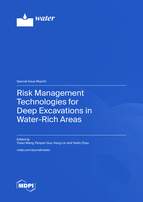Risk Management Technologies for Deep Excavations in Water-Rich Areas
A special issue of Water (ISSN 2073-4441). This special issue belongs to the section "Hydrogeology".
Deadline for manuscript submissions: closed (8 November 2023) | Viewed by 32007
Special Issue Editors
Interests: rock mechanics; soil mechanics; tunnelling technology; ground improvement; carbon capture and storage; underground infrastructures
Special Issues, Collections and Topics in MDPI journals
Interests: geotechnical engineering; tunnelling; excavation; soil mechanics; rock mechanics
Special Issues, Collections and Topics in MDPI journals
Interests: numerical calculation of geotechnical engineering; joint mechanics; slope engineering; tunnel engineering; safety management and prediction system
Special Issues, Collections and Topics in MDPI journals
Interests: multi-field coupling; hydraulic fracturing; geothermal system; computational geomechanics
Special Issues, Collections and Topics in MDPI journals
Special Issue Information
Dear Colleagues,
Due to the adverse effect of high hydraulic head pressure in water-rich area, deep excavations in that area inevitably involve a relatively high risk of instabilities, such as water burst, mud gushing, and sand inrush, which might result in large-scale failures imperiling human lives, personnel property, and economic balance. Risk management for deep excavations in water-rich areas is a systematic process of identifying potential hazards and mitigating them in order to maintain a specified degree of safety throughout the duration of the project. In engineering practice, the commonly adopted countermeasure against the detriment of water infiltration induced by great water head difference is carrying out dewatering during the construction of deep excavation in water-rich areas. However, improper dewatering can yield unbalanced ground stress, which gives rise to overlarge ground movements, lateral wall deformations, and collapse or failure of adjacent buildings and infrastructures.
The objective of this Special Issue is to provide a platform for researchers to report new advances in risk management technologies for deep excavations in water-rich areas and their many applications. Both original research and review articles are welcome.
Potential topics include but are not limited to the following:
- Role of groundwater in affecting the stability of deep excavations
- Method for assessing the risks in various stages
- Identification of hazards during the entire phase
- Precautions for reducing the risk of certain dangers
- In situ instrumentation methods and result interpretation
- Environmental effects of deep excavations
- Mechanism of soil–groundwater–structure interactions
- Innovation of excavation supporting systems
- Numerical modeling of three-dimensional deep excavation behavior
- Analytical methods for predicting risks and responses
Prof. Dr. Yixian Wang
Dr. Panpan Guo
Prof. Dr. Hang Lin
Prof. Dr. Yanlin Zhao
Guest Editors
Manuscript Submission Information
Manuscripts should be submitted online at www.mdpi.com by registering and logging in to this website. Once you are registered, click here to go to the submission form. Manuscripts can be submitted until the deadline. All submissions that pass pre-check are peer-reviewed. Accepted papers will be published continuously in the journal (as soon as accepted) and will be listed together on the special issue website. Research articles, review articles as well as short communications are invited. For planned papers, a title and short abstract (about 100 words) can be sent to the Editorial Office for announcement on this website.
Submitted manuscripts should not have been published previously, nor be under consideration for publication elsewhere (except conference proceedings papers). All manuscripts are thoroughly refereed through a single-blind peer-review process. A guide for authors and other relevant information for submission of manuscripts is available on the Instructions for Authors page. Water is an international peer-reviewed open access semimonthly journal published by MDPI.
Please visit the Instructions for Authors page before submitting a manuscript. The Article Processing Charge (APC) for publication in this open access journal is 2600 CHF (Swiss Francs). Submitted papers should be well formatted and use good English. Authors may use MDPI's English editing service prior to publication or during author revisions.
Keywords
- groundwater
- hydrogeology
- geotechnical engineering
- deep excavation
- risk management
- ground deformation









